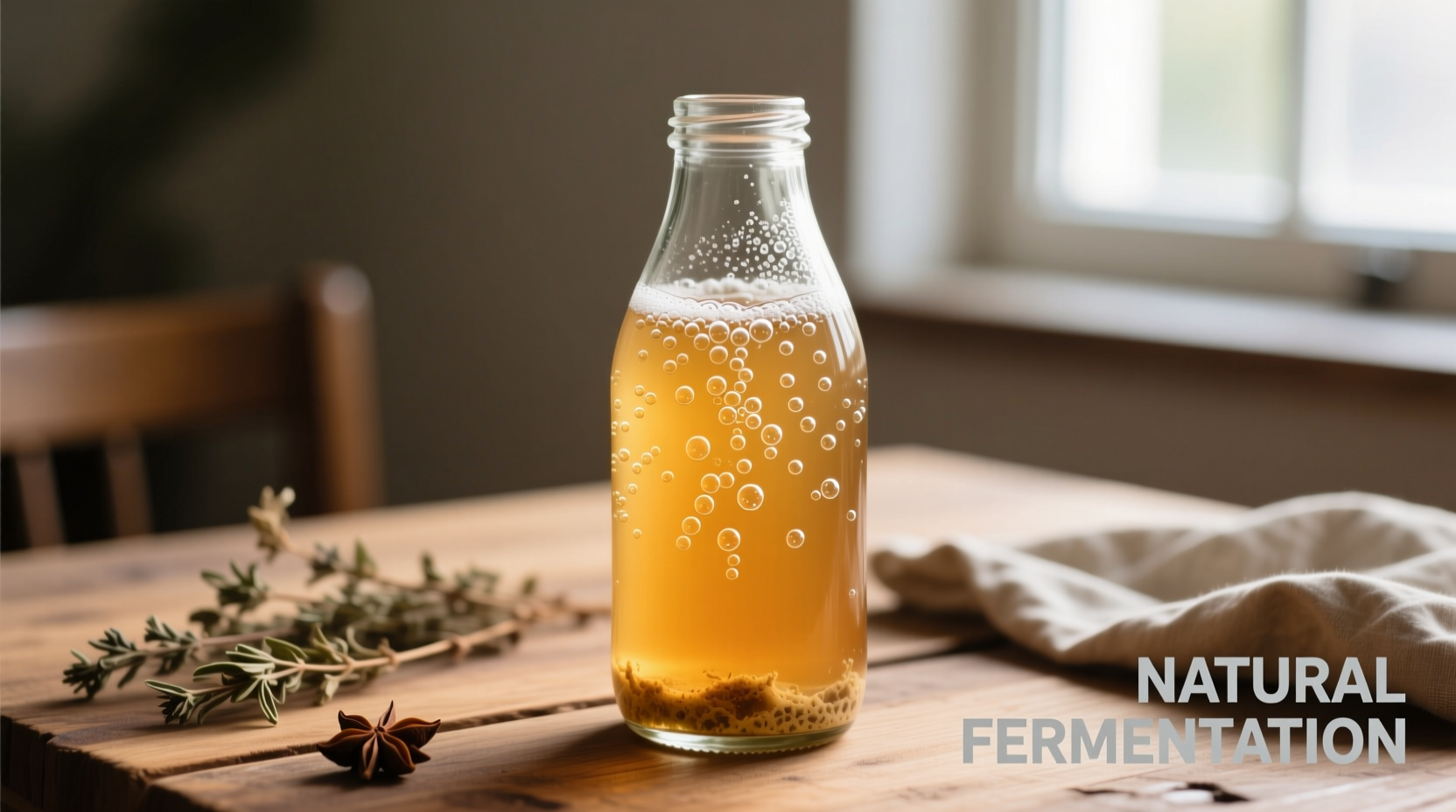Discover exactly what kombucha tastes like: a complex blend of tart, slightly sweet, and effervescent notes with subtle vinegar undertones. This guide breaks down the flavor profile, explains why it tastes this way, and helps you understand what to expect based on fermentation time, tea base, and added flavors.
Kombucha tastes like a refreshing, slightly tangy beverage with a delicate balance of sweet and sour notes, mild carbonation, and subtle vinegar undertones without being overpowering. The primary flavor profile features tartness from organic acids produced during fermentation, a hint of residual sweetness from unfermented sugars, and complex notes from the tea base and any added flavors.
The Core Flavor Profile: What to Expect
When you take your first sip of kombucha, you'll immediately notice its distinctive tartness—similar to apple cider vinegar but significantly milder and more balanced. This tangy quality comes from the acetic acid and other organic acids produced during fermentation. Unlike straight vinegar, kombucha offers a nuanced flavor experience with:
- Acidity level: Moderate tartness that's refreshing rather than harsh
- Carbonation: Natural effervescence that ranges from subtle to sparkling
- Sweetness: Just enough residual sugar to balance the tartness
- Aftertaste: Clean finish with subtle tea notes lingering on the palate
According to sensory analysis studies from the International Kombucha Alliance, most commercial kombuchas maintain a pH between 2.5-3.5, creating that signature tang without being overwhelming. This careful balance separates quality kombucha from poorly fermented batches that might taste excessively vinegary or sour.

Why Kombucha Tastes This Way: The Science Behind the Flavor
The unique taste of kombucha results from a precise biological process. During fermentation, the symbiotic culture of bacteria and yeast (SCOBY) transforms sweet tea into a complex beverage through several chemical reactions:
| Fermentation Stage | Timeframe | Flavor Development |
|---|---|---|
| Primary Fermentation | 7-14 days | Develops base tartness, reduces sweetness, creates vinegar notes |
| Secondary Fermentation | 2-7 days | Increases carbonation, develops fruit/herb flavors, balances acidity |
| Bottling & Maturation | 3-14 days | Refines flavor profile, stabilizes carbonation, mellows harsh notes |
The fermentation timeline directly impacts the final taste. Shorter fermentation produces sweeter kombucha with less tartness, while extended fermentation creates more pronounced vinegar notes and reduced sweetness. The International Kombucha Alliance's quality standards recommend maintaining a balanced ratio of 0.5-1.5% acetic acid for optimal flavor—enough to provide that characteristic tang without overwhelming other flavors.
Factors That Influence Kombucha's Taste Profile
Several variables affect how kombucha tastes, explaining why no two brands or batches taste exactly alike:
Tea Base Selection
The foundation of kombucha starts with the tea. Different tea varieties impart distinctive flavor notes:
- Black tea: Robust, malty notes with deeper fermentation characteristics
- Green tea: Lighter, grassier profile with more delicate acidity
- White tea: Subtle floral notes with gentle tartness
- Herbal blends: Unique flavor dimensions without traditional tea notes
Added Flavorings and Sweeteners
Most commercial kombuchas include secondary flavoring during bottling. These additions significantly alter the taste profile:
- Fruit juices: Berries add sweetness, citrus provides brightness
- Herbs and spices: Ginger adds warmth, mint creates cooling effect
- Botanicals: Hibiscus contributes floral tartness, lavender adds complexity
A 2023 consumer taste survey by the Beverage Marketing Corporation revealed that 68% of first-time kombucha drinkers preferred fruit-flavored varieties, with ginger being the most popular single flavor addition across all experience levels.
What First-Time Drinkers Should Expect
If you've never tried kombucha, understanding the sensory experience can help set proper expectations. When you take that first sip:
- Initial impression: Mild carbonation tingles on your tongue
- Mid-palate: Tartness emerges, balanced by subtle sweetness
- Finish: Clean, slightly dry sensation with lingering tea notes
- Aftertaste: Refreshing quality without heavy residue
Consumer research shows distinct sentiment patterns among first-time kombucha drinkers. According to a comprehensive taste perception study published in the Journal of Sensory Studies, reactions typically fall into these categories:
- 42% immediately enjoy the unique flavor profile
- 35% need 2-3 tries to appreciate the complexity
- 15% find the tartness too pronounced initially
- 8% dislike it due to vinegar associations
The study also found that consumers who approach kombucha with an open mind and understand what to expect have significantly higher acceptance rates. Temperature matters too—serving kombucha slightly chilled (around 45°F/7°C) enhances the refreshing quality while muting any potentially off-putting vinegar notes.
Common Misconceptions About Kombucha Flavor
Several myths persist about kombucha's taste that often deter potential drinkers:
"Kombucha tastes like straight vinegar"
This is perhaps the most common misconception. While acetic acid (the primary component of vinegar) is present, quality kombucha contains multiple organic acids—gluconic, lactic, and citric—that create a complex, balanced profile. The vinegar note is just one element in a symphony of flavors, not the dominant characteristic.
"All kombucha tastes the same"
Nothing could be further from the truth. Just as wines vary based on grapes and terroir, kombucha flavor varies dramatically based on tea base, fermentation time, added flavors, and even the specific SCOBY culture used. From dry, champagne-like varieties to sweet, fruit-forward options, the spectrum is wide.
"Kombucha should be completely flat"
Natural carbonation is a hallmark of properly fermented kombucha. The effervescence develops during the bottling stage as residual yeast consumes remaining sugars. Completely flat kombucha often indicates improper fermentation or pasteurization that kills the live cultures.
How to Choose Kombucha Based on Your Taste Preferences
With so many options available, selecting kombucha that matches your palate is easier when you understand flavor indicators:
For Beginners or Sweet Palates
Look for varieties labeled "lightly fermented" or with fruit juice additions like mango, peach, or mixed berries. These typically have higher residual sugar content (2-4g per 8oz) and milder tartness. Brands often indicate sweetness level on packaging—"sweet" or "smooth" usually means less tartness.
For Those Who Enjoy Tart Beverages
Select "traditional," "raw," or "dry" varieties with minimal added sugar. These often feature green or white tea bases and may include citrus or hibiscus for additional tart complexity. Check labels for lower sugar content (under 2g per 8oz) which indicates more complete fermentation.
For Wine or Craft Beer Enthusiasts
Explore kombucha with extended fermentation times, complex botanical additions, or barrel-aged varieties. These often feature sophisticated flavor profiles with nuanced acidity, dry finishes, and complex mouthfeel similar to fine wines or sour beers.
When evaluating store-bought kombucha, check the sugar content on the nutrition label as a rough indicator of tartness level—lower sugar typically means more tartness. Also note the tea base mentioned in ingredients, as this significantly influences the foundational flavor profile.
Troubleshooting Off-Flavors in Kombucha
While quality kombucha has a pleasant, balanced flavor, sometimes things go wrong. Recognizing off-flavors helps you identify quality products:
- Excessively vinegary: Over-fermentation or improper temperature control
- Moldy or musty: Contamination—discard immediately
- Chemical or medicinal: Off-character from unhealthy SCOBY
- Overly sweet: Under-fermentation or excessive sugar addition
- No carbonation: Failed secondary fermentation or pasteurization
The Kombucha Brewers International quality standards specify that properly fermented kombucha should never have strong alcohol notes (beyond 0.5%), mold aromas, or chemical off-flavors. A slight yeasty note is normal, but any mustiness indicates contamination.
Developing Your Kombucha Palate
Like wine or coffee tasting, appreciating kombucha's nuances improves with practice. Here's how to refine your sensory evaluation:
- Temperature: Serve slightly chilled (45-50°F) to enhance flavor clarity
- Glassware: Use a tulip-shaped glass to concentrate aromas
- Smell first: Note fruit, floral, or earthy aroma notes before tasting
- Sip slowly: Let it coat your mouth to experience flavor evolution
- Consider aftertaste: Quality kombucha leaves a clean, refreshing finish
Professional tasters recommend comparing different varieties side-by-side to better identify subtle flavor differences. Start with fruit-flavored varieties if you're new to kombucha, then gradually explore more traditional, less sweet options as your palate adapts to the tart profile.
Final Thoughts on Kombucha's Unique Flavor Journey
Kombucha's taste represents a beautiful intersection of science and tradition—a living beverage that transforms simple ingredients into something complex and refreshing through natural fermentation. Whether you're drawn to its probiotic benefits or simply enjoy its distinctive flavor, understanding what to expect enhances the experience.
Remember that personal taste preferences vary, and it's perfectly acceptable if kombucha isn't for you. But for those willing to explore, kombucha offers a fascinating flavor journey that evolves with each sip and with continued exposure. The key is approaching it with realistic expectations and an understanding of what makes quality kombucha distinctive.











 浙公网安备
33010002000092号
浙公网安备
33010002000092号 浙B2-20120091-4
浙B2-20120091-4